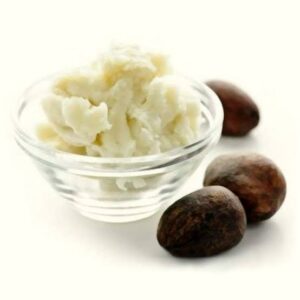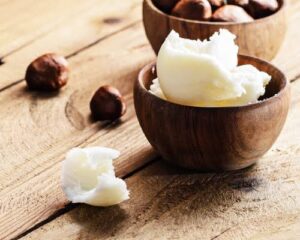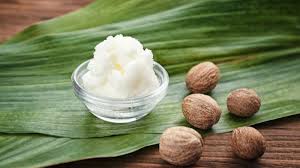Shea butter processing refers to the various methods used to extract the butter from the nuts of the African shea tree. The process typically involves several steps, including harvesting, drying, cracking, roasting, grinding, and separating the butter from other materials.
Shea butter is a fat that is derived from the nuts of the African shea tree (Vitellaria paradoxa). It is a popular ingredient in cosmetics and personal care products due to its moisturizing and nourishing properties.
Shea butter is rich in fatty acids and vitamins, including vitamin A, vitamin E, and vitamin F. It is commonly used in skincare products for its ability to soothe and protect the skin, and can be used to treat dry skin, eczema, psoriasis, and other skin conditions. It is also believed to have anti-inflammatory and anti-aging properties.
In addition to its skincare benefits, shea butter can also be used in hair care products to moisturize and condition hair, and is sometimes used in cooking as a substitute for butter or oil.
Shea butter is typically solid at room temperature but can be melted down and used in various formulations. When purchasing shea butter, it is important to look for unrefined, raw shea butter to ensure that it retains its natural nutrients and benefits.
Read Also: Basket of Gold Flowers – All You Need to Know
Shea Butter Processing

The first step in shea butter processing is harvesting the shea nuts from the tree. The nuts are then left to dry in the sun for several days, or they may be dried using artificial means such as ovens or kilns.
Once the nuts are dried, they are cracked open to reveal the kernel inside. The kernel is then roasted, either over an open flame or in an oven, to enhance the flavor and aroma of the butter.
After roasting, the kernels are ground into a paste using a mortar and pestle or a mechanical grinder. The paste is then mixed with water and kneaded to separate the butter from any remaining solids.
The butter is then left to solidify and is typically stored in blocks or other forms until it is ready for use. Depending on the level of processing, shea butter may be refined to remove any impurities or odor, or it may be left unrefined for maximum nutrient content.
Overall, shea butter processing can vary depending on the specific methods and equipment used, but the goal is to extract the valuable butter from the shea nuts in a way that maximizes its quality and benefits.
Shea Butter Processing Guide

Shea butter is a popular natural butter that is used for a variety of purposes, including cooking, cosmetics, and medicine. Shea butter is derived from the nuts of the shea tree, which is native to Africa. The processing of shea butter involves several steps, which are discussed below:
Harvesting: The first step in shea butter processing is the harvesting of the shea nuts from the shea tree. The shea nuts are harvested by hand or with the help of a long stick, which is used to knock the nuts from the tree.
Drying: After harvesting, the shea nuts are left to dry in the sun for several days. This helps to remove any moisture from the nuts and makes them easier to process.
Crushing: Once the shea nuts are dry, they are crushed using a mortar and pestle or a mechanical crusher. This breaks the nuts into small pieces and makes them easier to roast.
Roasting: The crushed shea nuts are then roasted in an oven or over an open flame. This helps to bring out the oils in the nuts and gives the shea butter its characteristic nutty aroma.
Grinding: After roasting, the shea nuts are ground into a fine powder using a mechanical grinder. This powder is then mixed with water to form a paste.
Kneading: The shea paste is then kneaded by hand or with a machine to separate the oil from the rest of the paste. This process is repeated several times to ensure that all of the oil is extracted.
Filtering: The extracted shea oil is then filtered to remove any impurities and to ensure that the oil is pure.
Solidifying: The filtered shea oil is then left to solidify at room temperature or in a refrigerator. Once solidified, the shea butter is ready to be used.
Additionally, shea butter processing is a time-consuming and labor-intensive process. However, the end result is a high-quality natural butter that is used in a variety of products around the world.
Health Benefits of Shea Butter
Shea butter is a fat extracted from the nuts of the shea tree. It has been used for centuries in West Africa for medicinal and cosmetic purposes. Here are some of the health benefits associated with Shea butter:
Moisturizes the skin: Shea butter is an excellent moisturizer for the skin. It contains high levels of fatty acids and vitamins that help to nourish and hydrate the skin, leaving it soft and supple.
Reduces inflammation: Shea butter has anti-inflammatory properties that can help to reduce inflammation and redness in the skin. It is often used to soothe skin conditions such as eczema and psoriasis.
Protects the skin from the sun: Shea butter contains cinnamic acid, a natural sunscreen that can help to protect the skin from the harmful effects of the sun.
Improves skin elasticity: Shea butter is rich in vitamin A, which can help to improve skin elasticity and reduce the appearance of wrinkles.
Reduces the appearance of scars: Shea butter contains triterpenes, which can help to reduce the appearance of scars and stretch marks.
Relieves muscle pain: Shea butter has anti-inflammatory properties that can help to relieve muscle pain and soreness.
Treats acne: Shea butter contains oleic, stearic, and palmitic acids, which can help to reduce inflammation and prevent acne breakouts.
Overall, Shea butter is a versatile and beneficial natural ingredient for the skin and body.
Uses of Shea Butter

Shea butter is a natural fat extracted from the nuts of the shea tree, which is native to West Africa. It has been used for centuries in Africa for its moisturizing and healing properties. Below are seven (7) common uses of shea butter:
Moisturizer: Shea butter is an excellent natural moisturizer that can be used on the face and body. It is rich in vitamins A and E and fatty acids, which help to nourish and hydrate the skin.
Sunburn relief: Shea butter has anti-inflammatory properties that can help soothe sunburned skin. Its moisturizing properties can also help to prevent peeling and dryness.
Stretch mark prevention: Shea butter can help to prevent and reduce the appearance of stretch marks. Its nourishing properties help to keep the skin supple and elastic, reducing the likelihood of stretch marks forming.
Hair conditioner: Shea butter can be used as a deep conditioner for the hair. Its moisturizing properties help to soften and nourish the hair, making it more manageable and reducing frizz.
Lip balm: Shea butter can be used as a natural lip balm. Its moisturizing properties help to keep lips soft and supple, and its anti-inflammatory properties can help soothe chapped or irritated lips.
Eczema and psoriasis: Shea butter has anti-inflammatory properties that can help to soothe and heal skin conditions such as eczema and psoriasis.
Insect bites: Shea butter can help to reduce itching and swelling from insect bites. Its anti-inflammatory properties can help to soothe the skin and reduce redness.
Additionally, shea butter is a versatile and natural ingredient that can be used for a variety of skin and hair care needs.
Read Also: All you need to know about Bee Balm Flowers
Economic Importance of Shea Butter
Shea butter has significant economic importance in West Africa, where it is traditionally produced and used. Here are some of the ways in which shea butter is economically important:
Employment: Shea butter production provides employment opportunities for millions of people, particularly women, in rural communities in West Africa. The process of harvesting and processing shea nuts is labor-intensive and involves several stages, including collection, sorting, drying, cracking, roasting, grinding, and kneading.
Income generation: Shea butter production is an important source of income for many families in West Africa. The sale of shea butter and other products made from it, such as soap and cosmetics, provides income for families to support their basic needs and improve their standard of living.
Trade: Shea butter is an important export commodity for many West African countries, including Ghana, Burkina Faso, Mali, and Nigeria. These countries export shea butter to other parts of the world, including Europe, the United States, and Asia.
Sustainable development: Shea butter production is an example of sustainable development, as it relies on a natural resource that is abundant in the region. Shea trees grow in the wild and require no irrigation or fertilizers, making them a low-impact crop that supports biodiversity and ecosystem health.
Health benefits: Shea butter has several health benefits and is used in many health and wellness products, including skin creams, lotions, and soaps. The demand for natural and organic products has increased in recent years, and shea butter has become a popular ingredient in many such products.
In conclusion, shea butter plays an important role in the economic development of West Africa and provides a sustainable source of income and employment for many communities. Its demand is increasing globally, providing opportunities for further growth and development in the region.
Read Also: Benefits of a Growing Business
Frequently Asked Questions
We will update this section soon.

